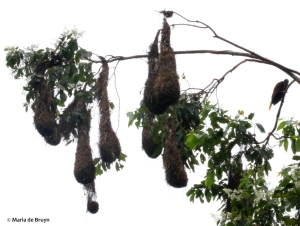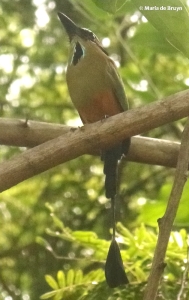 I don’t know how many of us would find a human being with an extremely large nose (e.g., even bigger than the face) and multi-colored head, facial and body hair to be beautiful or even attractive. Perhaps it would depend on the nose shape and which color combinations would be in play? But it is certainly a fact that many of us find big-beaked, multi-hued birds to be alluring and enticing, if not just plain gorgeous, magnificent and delightful to say the least.
I don’t know how many of us would find a human being with an extremely large nose (e.g., even bigger than the face) and multi-colored head, facial and body hair to be beautiful or even attractive. Perhaps it would depend on the nose shape and which color combinations would be in play? But it is certainly a fact that many of us find big-beaked, multi-hued birds to be alluring and enticing, if not just plain gorgeous, magnificent and delightful to say the least.
 Well, Costa Rica does not lack for a variety of big-beaked birds and I found them all appealing, each in their own way. Some were not completely colorful but had splashes of color, like the brown-hued Montezuma oropendola (Psarocolius montezuma) with its white bare patch on the cheek with a pink wattle underneath and mostly yellow tail feathers.
Well, Costa Rica does not lack for a variety of big-beaked birds and I found them all appealing, each in their own way. Some were not completely colorful but had splashes of color, like the brown-hued Montezuma oropendola (Psarocolius montezuma) with its white bare patch on the cheek with a pink wattle underneath and mostly yellow tail feathers.
An unusual fact about this bird is that the males are generally twice as heavy as the females. They are called “colonial” nesters, meaning that the females build their pendulous nests (24-71 in/60–180 cm long) near one another in “colonies”. Unfortunately, their nest success is not great with only about one-third of colony nests resulting in a fledgling!
These oropendolas tend to forage in small groups in the tree canopies, searching for insects and fruit. Their love of fruit also brings them to feeding platforms, like this one set up to not only entice birds but also the tourists who want to see them. They seemed to especially enjoy papayas and watermelon.
The call that the males especially emit from their bi-colored black and red-tipped beaks is said to resemble water being poured from a bottle, bubbling and gurgling.
 The chestnut-headed oropendola (Psarocolius wagleri) resembles the Montezuma species but is a bit less colorful with a pale bill. They are a bit smaller than the Montezumas and fly more quickly. Like their cousins, their broods in hanging nests are also threatened by giant cowbirds (nest parasites) and botflies.
The chestnut-headed oropendola (Psarocolius wagleri) resembles the Montezuma species but is a bit less colorful with a pale bill. They are a bit smaller than the Montezumas and fly more quickly. Like their cousins, their broods in hanging nests are also threatened by giant cowbirds (nest parasites) and botflies.
 We were lucky to see two toucans and a toucanet during our trip to Costa Rica this past year. We had a glimpse of a keel-billed toucan (Ramphastos sulfuratus) high up in trees on a cloudy day. Their large bill measures 4.7-5.9 in (12–15 cm), which is about one-third the size of their entire length! Their zygodactyl feet (two toes facing forwards and two facing backwards) help them balance on branches.
We were lucky to see two toucans and a toucanet during our trip to Costa Rica this past year. We had a glimpse of a keel-billed toucan (Ramphastos sulfuratus) high up in trees on a cloudy day. Their large bill measures 4.7-5.9 in (12–15 cm), which is about one-third the size of their entire length! Their zygodactyl feet (two toes facing forwards and two facing backwards) help them balance on branches.
We got an up-close and personal view of a couple when we visited a hotel with an adjacent bird park and animal displays. A couple of these birds were in a large aviary, accompanied by two attendants who let people pose for photos with them. I just took photos of the birds and did not have a self-portrait done.
 The second toucan that we got to see was the yellow-throated toucan (Ramphastos ambiguus), one of whom seemed to be posing for us during an early morning walk. They have an even larger bill than the keel-billed toucan, which ranges in length from 5.1-7.9 in (12.9-20 cm).
The second toucan that we got to see was the yellow-throated toucan (Ramphastos ambiguus), one of whom seemed to be posing for us during an early morning walk. They have an even larger bill than the keel-billed toucan, which ranges in length from 5.1-7.9 in (12.9-20 cm).
In 2018, I was able to photograph a couple that were flying by over a river.
The Northern emerald toucanet (Aulacorhynchus prasinus) is a smaller toucan that also sports a large beak in comparison to its head size. We saw one of these birds every morning at one hotel where we stayed as it was hanging out in trees next to our room cabins. It was often overcast, however, and it wasn’t easy to get a good photo; the same situation arose several days later when we saw one on another rainy day.
Luckily, that bird came down to a feeding station set up to attract birds for tourists. You can see its beautiful green body set off with a multi-colored bill that has a distinctive white band at the base.
Like other toucans, the toucanet will eat insects and lizards but it, too, has a real fondness for fruit meals, especially berries.
In contrast to the oropendolas, this bird’s calls resemble frog croaking and barking!
Unfortunately, it appears that these birds are popular as pets and they are taken from the wild to live in cages. They are popular because they can be affectionate and interact with their “owners” and they can learn tricks.
Going back to the bigger birds, Costa Rica has two aracaris, which are also members of the toucan group. They differ from other toucans in their sociability, often roosting in groups of several birds.
We did not see the fiery-billed aracari (Pteroglossus frantzii) during our August 2019 trip, but I had seen one flying by during a trip to Costa Rica in 2018.
It looks similar to the collared aracari but is distinguished by a bright red breast band and its bill is somewhat more colorful. It, too, is mainly frugivorous.
The collared aracari (Pteroglossus torquatus) was a frequently seen bird during our August trip through Costa Rica.
We visited several spots where people were earning tourist dollars by setting up feeding stations with plenty of fruit to attract a variety of birds. The aracaris were enthusiastic and voracious feeder visitors.
When the young aracaris are born, they are blind, naked and have short bills. Their feet also have specialized heel pads to help protect their feet from the rough nest floor. Not only the parents but also other birds help feed them for six weeks, at which point they fledge. The adults will still feed them for a time after they leave the nest as well.
These aracaris are interesting in that their large colorful bills also have a sawtooth pattern on the cutting edges. It can take up to a year for the young birds to develop the notches and color pattern on their beaks.
Now all these photos might give the impression that all the big-beaked birds are large in size, but this is definitely not the case. There are also medium- and small-sized colorful birds that tote around bills large in size when compared to their heads. Among the middle-sized range are two beautiful motmots.
We saw our first turquoise-browed motmot (Eumomota superciliosa) early one morning when it was still dark. A flashlight showed the bird sitting quietly in a tree as we made our way to breakfast. Oddly (to me at least), it didn’t seem very bothered by the bright light and just watched us as we drew near.
We later saw one sitting in a shady area alongside a road. They often perch on fences and wires as well, scanning the area for their diet of insects and lizards. They use their racketed tails for communication purposes, as part of a mating display or as a “pursuit-deterrent signal” to warn predators that they have been seen and will not be able to capture the aware birds. In Costa Rica, these birds have the nickname pájaro bobo (foolish bird) because they will allow humans to get quite near.
The broad-billed motmot (Electron platyrhynchum) is also an insectivore and has not been seen consuming fruit. These motmots are less studied than the turquoise-browed species; for example, it is not known how they use the tail rackets for communication.
The smallest bird in this account of the big-beaked avians is the rufous-tailed jacamar (Galbula ruficauda), which I first thought might be a large hummingbird. (Some hummers also have enormously large bills and will feature in a later blog.) They measure only 10 inches long (25 cm) with a 2-inch (5 cm) bill.
They are insectivores who will remove an insect’s wings before they swallow it. A surprising finding for me was that they nest in bare earth burrows. They do not keep the burrows clean and the nestlings do not lie down but remain standing so that they protect their feathers from accumulated debris!
On that surprising note, I wish my blog readers a wonderful start to the next decade and hope you all will have a great 2020 with good health, a comfortable living situation and as many hours enjoying our beautiful natural world as possible!








































I thoroughly enjoyed this blog Maria. That was an amazing trip you had and thank you for sharing it with us. I wish you much health and happiness throughout the year.
LikeLiked by 1 person
Glad you enjoyed it, Karla. May 2020 also bring you and Chris good health and happiness!
LikeLike
I always learn so much through your blogs, but of course this one was special since I was along on the August trip! Thanks for spending so much time to compile your photos and add interesting information. I could do that exact same trip again! Have a wonderful 2020, and I hope to continue to share in some adventures in nature with you Maria!
LikeLiked by 1 person
Thanks for your nice feedback, Nan. It’s gratifying that other people are also learning some new things through the blogs; I know I enjoy finding out new information about the various wildlife species and always hope others do, too. I look forward to sharing some nature adventures with you as well!
LikeLike
Maria, I really enjoyed this post. Your photos are beautiful, and I especially love your focus on information and bird behavior. I know so little about neotropical birds and you have piqued my interest. In fact, I just got off of The Cornell Laboratory of Ornithology’s website reading more. Looks like they are in the process of building their neotropical bird information and there’s a note that they are looking for photos. Bet they would love to see yours! Thanks again for sharing what you have seen and learned:)
LikeLiked by 1 person
Thanks, Gina – cool that you have developed a new interest through the blog. There will be some more in the coming months as I am slow in processing photos, identifying species and then thinking of the blogs’ focus each time. Look forward to your comments in this new year of the new decade! Best wishes for a great year!
LikeLike